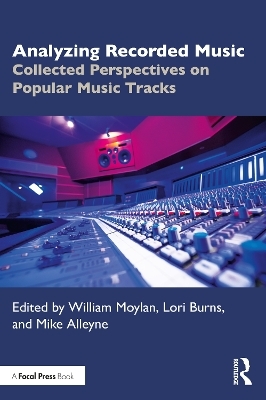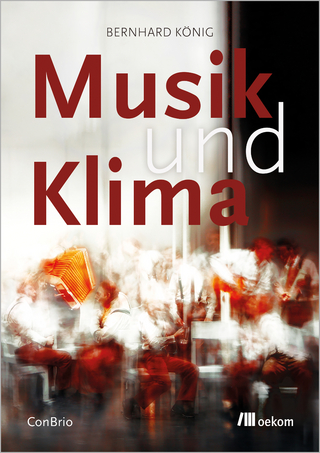
Analyzing Recorded Music
CRC Press (Verlag)
978-0-367-54631-1 (ISBN)
Examining a diverse set of songs from a range of genres and points in history (spanning the years 1936–2020), the authors herein illuminate unique attributes of the selected tracks and reveal how the recording develops the expressive content of song performance.
Analyzing Recorded Music will interest all those who study popular music, cultural studies, and the musicology of record production, as well as popular music listeners.
William Moylan is Distinguished University Professor (2019–2022) at the University of Massachusetts Lowell, where he is a Professor of Music and Sound Recording Technology and served as Chairperson of the Department of Music. As a recording engineer and a producer, he has worked with emerging and leading artists across a broad spectrum of popular and classical genres. William Moylan is the author of Understanding and Crafting the Mix, 3rd Edition (Focal Press, Routledge, 2015) and Recording Analysis: How the Record Shapes the Song (Focal Press, Routledge, 2020). Lori Burns is Professor of Music at the University of Ottawa. Burns’ interdisciplinary research merges musical analysis and cultural theory to explore representations of gender in the lyrical, musical, and visual texts of popular music. Her monograph, Disruptive Divas: Feminism, Identity, and Popular Music (2002), won the Pauline Alderman Award from the International Alliance for Women in Music (2005). She is co-editor of two previous essay collections: The Pop Palimpsest (2018) and The Bloomsbury Handbook of Popular Music Video Analysis (2019). She is co-editor of the Ashgate Popular and Folk Music Series and Associate Editor of Music Theory Spectrum. Mike Alleyne is Professor Emeritus with the Department of Recording Industry, Middle Tennessee State University (MTSU) and a Visiting Professor at the Pop Akademie in Germany. His work has been published in Popular Music & Society, Rock Music Studies, and Billboard magazine. His books include The Essential Hendrix (2020) and The Encyclopedia of Reggae (2012), and a co-edited collection entitlted Prince and Popular Music (2020). He also writes and edits for the SAGE Business Case Series in Music Marketing and contributed liner notes to the groundbreaking 9-CD box set, The Smithsonian Anthology of Hip-Hop and Rap (2021).
Section I: Musical Genre, Culture, and Technology 1. "I Been Studying Rain": What Do We Hear When We Listen to the Blues of Robert Johnson? ("Preachin’ Blues," 1936) 2. Analyzing Hip-Hop Hacktivism and Automobility in Injury Reserve’s (2019) "Jailbreak the Tesla" (feat. Aminé) Section II: Track Revelations and Aural Mirrors 3. Hearing through the Grapevine: Marvin Gaye, Norman Whitfield and the Long Journey of Motown’s Biggest Hit (1967) 4. "Let the Music Play" (1975): Hearing the Disco Mainstream in Barry White 5. Reaching for Stardom: Live and Studio Sound in Prince’s "Purple Rain" (1984) Section III: Layers Make the Record 6. "In a Sky Full of People": Spatial and Cinematic Staging in Seal’s "Crazy" (1990) 7. Come Together: Feeling the Distemper of Murk and Elation with the Beatles (1969) and with Sheila E. and Ringo Starr (2017 and 2020) 8. "A Tsunami of Voices": 10cc’s "I’m Not in Love" (1975) 9. Counterpoint and Expression in the Music of U2: "Gloria" (1981) Section IV: Sonic Journeys 10. On the Structure of Feeling in Bob Dylan’s "I’ve Made Up My Mind to Give Myself to You" (2020) 11. "You Never Give Me Your Money": The Abbey Road Medley (1969) 12. Listening Beyond the Recording: The Judds’ "John Deere Tractor" (1984) Section V: Sampling and Reframing 13. Sonic Materiality and Boom-Bap Embodiment in Conway’s "Biscotti Biscuit" (2018): An Autoethnography of Recording Analysis 14. "It Ain’t But One Kind of Blues": Kid Koala’s Bluesy Embrace of the Fragmented (2012) 15. "Three and a Half Minutes of Attitude": Vocal Delivery, Groove, and Production in Azealia Banks’ "212" (2014) Section VI: Deconstructing the Mix and Production Process 16. Can You Hear the Thunder? The Tech-Processual Construction of Environmental and Emotional Situ in Ghost’s "Cirice" (2015) 17. Three-Dimensional Doom: My Dying Bride’s "Your Broken Shore" (2020) 18. Transforming A Pop Song: The Journey of the Extended Club Remix (Taz Vegas’ "Am I Dreaming," 2019) Section VII: Voicing Identity through Genre 19. Framing the Female Voice in Doom Metal: Compositional and Sonic Elements in The Gathering’s "Strange Machines" (Mandylion, 1995) 20. Masking: Queer Aesthetics and Production Tricks in Orville Peck’s "Hope to Die" (2019) 21. "What Are You Gonna Tell Her?" (2020): Mickey Guyton’s Advocacy and Protest for Equality in Country Music 22. Form, Genre, and Vocal Performance in Nicki Minaj’s "Stupid Hoe" (2011) 23. Tracks and Transformations in The Wailers’ "Concrete Jungle" (1973)
| Erscheinungsdatum | 16.12.2022 |
|---|---|
| Zusatzinfo | 17 Tables, black and white; 40 Line drawings, black and white; 33 Halftones, black and white; 73 Illustrations, black and white |
| Verlagsort | London |
| Sprache | englisch |
| Maße | 156 x 234 mm |
| Gewicht | 980 g |
| Themenwelt | Kunst / Musik / Theater ► Musik ► Musiktheorie / Musiklehre |
| Kunst / Musik / Theater ► Musik ► Pop / Rock | |
| ISBN-10 | 0-367-54631-0 / 0367546310 |
| ISBN-13 | 978-0-367-54631-1 / 9780367546311 |
| Zustand | Neuware |
| Informationen gemäß Produktsicherheitsverordnung (GPSR) | |
| Haben Sie eine Frage zum Produkt? |
aus dem Bereich


